 W
WThe British Columbia Legislature Cenotaph, also known as the Victoria Cenotaph and the War Memorial to the Unknown Soldier, is a war memorial, installed outside the British Columbia Parliament Buildings in Victoria, British Columbia, Canada. Unveiled by Lt.-Gov. W.C. Nichol on July 12, 1925, the granite cenotaph commemorates the sacrifices of Canadian Forces personnel and citizens during both World Wars, the Korean War and peacekeeping missions. The bronze statue was designed by sculptors Vernon and Sidney March.
 W
WThe Cenotaph is a war memorial on Heerengracht Street in Cape Town. The city's annual Remembrance Day ceremonies are held there. It is classified as a public memorial and as such is subject to protection in terms of heritage legislation administered by Heritage Western Cape, the provincial heritage resources authority of the Western Cape province of South Africa.
 W
WCharlestown Veterans Memorial Park is a park in Charlestown, Boston, Massachusetts, United States. The park has memorials commemorating Korean War and Vietnam War veterans.
 W
WThe Clarke Memorial Fountain is a large public fountain on the campus of the University of Notre Dame in Notre Dame, Indiana, United States.
 W
WThe Daejeon National Cemetery is located in Hyeonchungwon-ro, Yuseong-gu, Daejeon, South Korea. It is South Korea's second national cemetery after the Seoul National Cemetery and is overseen by the Ministry of Patriots' and Veterans' Affairs.
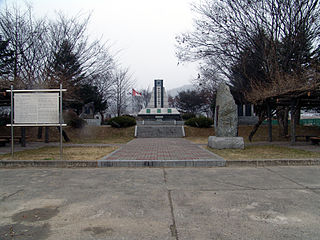 W
WThe Gapyeong Canada Monument is a monument erected to commemorate the sacrifice of the Canadian Forces during the Korean War, especially at the Battle of Kapyong in the Canadian Korean War Memorial Garden. The English text describing the monument reads as follows:Korean War Monument to the Canadian Armed Forces This monument, located at 207-4 Igokri. Puk-myeon, Gapyeong-gun Gyeonggi-do Province, was erected by Gapyeong-gun, County on December 30, 1983 to replace an earlier monument erected by the U. N. Korean War Allies monument citizens of Gapyeong County in November 1975. The 6.5-meter monument rests on a 70-centimeter foundation in a 1,688 squaremeter site. The design of the monument is taken from the Canadian flag. It commemorates the victory of the Canadian troops in the Battle of Gapyeong on April 24 and 25, 1951. When the Korean War began with a surprise attack on the South by Communist North Korea, Canada dispatched its forces to help defend the freedom of Korea and the peace of the world. The Canadian troops arrived in Korea in August 1950 and engaged in mopping up operations in the Samnyangjin area. They then moved north to fight in the Battle of Gapyeong and in other battles, advancing eight kilometers north of the 38th parallel. Securing a position at the confluence of the Han-gang and Imjim-gang Rivers, the Canadian troops occupied a high point north of Kaesong and conducted more than 1,000 reconnaissance operations.
 W
WThe Gloucester Valley Battle Monument or Gloucester Memorial is a memorial in South Korea that commemorates the actions of the Gloucestershire Regiment and C Troop, 170th Mortar Battery, Royal Artillery, of the British Army during the Battle of the Imjin River in 1951.
 W
WThe Korean War Memorial is a monument commemorating those who fought in the Korean War, installed outside the Veterans Building in Salem, Oregon, United States, which houses the offices of the Oregon Department of Veterans' Affairs.
 W
WThe Korean War Memorial silver dollar is a commemorative silver dollar issued by the United States Mint in 1991. The coin commemorated the 38th anniversary of the end of the Korean War.
 W
WThe Korea Veterans Association of Canada erected a Wall of Remembrance to the 516 Canadians who are commemorated in the Korean War Book of Remembrance.
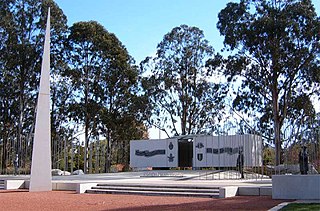 W
WThe Australian National Korean War Memorial is on Anzac Parade, the principal ceremonial and memorial avenue in Canberra, the national capital city of Australia.
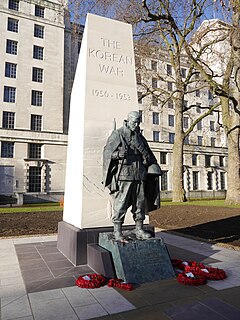 W
WA memorial to the British soldiers in the Korean War was unveiled in Victoria Embankment Gardens, between the River Thames and the Ministry of Defence headquarters in London, England, in December 2014. The memorial, a bronze statue of a British soldier by the sculptor Philip Jackson, with a Portland stone obelisk on a Welsh slate base, was a gift from the Government of South Korea and was unveiled in a ceremony led by Prince Richard, Duke of Gloucester.
 W
WThe Korean War Veterans Memorial is located in Washington, D.C.'s West Potomac Park, southeast of the Lincoln Memorial and just south of the Reflecting Pool on the National Mall. It memorializes those who served in the Korean War.
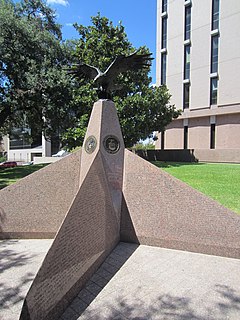 W
WThe Korean War Veterans Memorial is an outdoor monument by Edward L. Hankey commemorating the more than 289,000 Texans who served in the Korean War, installed on the Texas State Capitol grounds, in Austin, Texas, United States. The memorial was erected in 1999 by the Texas Lone Star Chapter of the Korean War Veterans Association. It features a star-shaped Texas Sunset Red Granite pedestal topped with a bronze sculpture of an eagle.
 W
WThe Korean War Veterans Memorial Bridge, formerly known as Gateway Bridge, is a vehicular bridge that carries Korean Veterans Boulevard over the Cumberland River in Nashville, within the U.S. state of Tennessee.
 W
WKorean War Veterans Plaza is a memorial plaza in Brooklyn, New York City, at Fulton and Tillary streets. The plaza features a gate and flagstaff, cast in 1992 and dedicated on November 11 of that year. The park is named in honor of the Brooklyn military personnel who served in the Korean War.
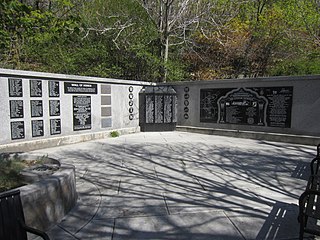 W
WThe Korean War Wall of Honor, or Utah Korean War Memorial, is a war memorial Memory Grove in Salt Lake City, Utah, United States.
 W
WThe Memorial Hall of the War to Resist US Aggression and Aid Korea, also translated as the Korean War Museum, is a museum in Dandong, Liaoning. It is the only official museum in China that memorializes the Korean War. First established in 1958, it was rebuilt at its current location in October 1990. The new museum was opened on 27 July 1993, the 40th anniversary of the Panmunjom armistice. Since 2014 it has been closed for refurbishment.
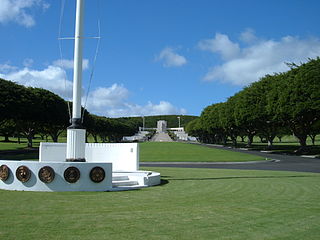 W
WThe National Memorial Cemetery of the Pacific is a national cemetery located at Punchbowl Crater in Honolulu, Hawaii. It serves as a memorial to honor those men and women who served in the United States Armed Forces, and those who have given their lives in doing so. It is administered by the National Cemetery Administration of the United States Department of Veterans Affairs and is listed on the National Register of Historic Places. Millions of visitors visit the cemetery each year, and it is one of the most popular tourist attractions in Hawaii.
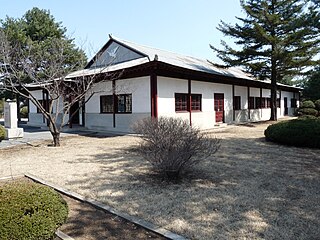 W
WThe North Korea Peace Museum is in the building constructed to house the signing of the Korean War Armistice Agreement on 27 July 1953. It is located in the former village of Panmunjeom (P'anmunjŏm) in North Hwanghae Province, North Korea.
 W
WThe Oregon Korean War Memorial is a war memorial located in Wilsonville, Oregon, United States. Completed in 2000, it honors the Oregon soldiers and the Korean people from the Korean War. The memorial is located within a 5.5-acre (22,000 m2) city park and features a 109-foot (33 m)-long granite wall that includes the names of those Oregonians who died or were listed as missing from the war.
 W
WThe Philadelphia Korean War Memorial at Penn's Landing in Philadelphia was initially dedicated on June 22, 2002 and was formally rededicated on Memorial Day, May 28, 2007 after additional work was completed. Each name of the more than 600 servicemen who were killed in action or listed as missing in action during the Korean War from Bucks, Chester, Delaware, Montgomery, and Philadelphia counties are etched in the memorial. Veterans Day and Memorial Day services are held onsite annually.
 W
WThe Seoul National Cemetery (Korean: 국립서울현충원) is located in Dongjak-dong, Dongjak-gu, Seoul, South Korea. The cemetery is reserved for Korean veterans, including those who died in the Korean independence movement, Korean War, and Vietnam War. Four South Korean presidents are buried in the cemetery.
 W
WThe Statue of Brothers is a symbol of the Korean War at the War Memorial of Korea in Seoul. Its English text reads as follows :"The Statue of Brothers is an 18 meter wide and 11-meter high symbol of the Korean War. It consists of the upper part, lower part and inner part. The upper part of the statue depicts a scene where a family's older brother, an ROK officer, and his younger brother, a North Korean soldier, meet in a battlefield and express reconciliation, love, and forgiveness. The lower tomb-shaped dome was built with pieces of granite collected from nationwide locations symbolizing the sacrifices made by our patriots. The crack in the dome stands for the division of Korea and the hope for reunification. Objects inside the dome include a mosaic wall painting that expresses the spirit of the Korean people to overcome the national tragedy and a map plate of the 16 UN Allied Nations that dispatched troops to the war. The links of iron chain on the ceiling signify the unbreakable bonds of a unified Korea."
 W
WThe Trenton Cenotaph is a memorial dedicated to the "fallen of all conflicts" located in Trenton, Ontario, Canada.
 W
WThe United Nations Memorial Cemetery in Korea, located at Tanggok in the Nam District, City of Busan, Republic of Korea, is a burial ground for United Nations Command (UNC) casualties of the Korean War. It contains 2,300 graves and is the only United Nations cemetery in the world. Laid out over 14 hectares, the graves are set out in 22 sites designated by the nationalities of the buried servicemembers.
 W
WThe Victorious War Museum, or the Victorious Fatherland Liberation War Museum, is a history/military museum dedicated to the Korean War located in the North Korean capital-city of Pyongyang.
 W
WThe War Memorial of Korea is a museum located in Yongsan-dong, Yongsan-gu, Seoul, South Korea. It opened in 1994 on the former site of the army headquarters to exhibit and memorialize the military history of Korea. It was built for the purpose of preventing war through lessons from the Korean War and for the hoped for peaceful reunification of North and South Korea. The memorial building has six indoor exhibition rooms and an outdoor exhibition centre displaying war memorabilia and military equipment from China, South Korea and the United States.
 W
WThe Yalu River Broken Bridge is a truncated railway swing bridge converted to a viewing platform and historical site. Constructed in 1911 by the Empire of Japan, it was the first bridge built across the Yalu River and connected the Chinese city of Dandong with the Korean city of Sinuiju, linking Japanese-ruled Korea to the Eurasian rail network. The bridge originally consisted of twelve truss spans supported by stone foundations in the riverbed. During the Korean War, the eight spans over the Korean side of the river were badly damaged by American bombing, and were subsequently dismantled. The bridge was not rebuilt. Instead, the remaining four spans over the Chinese side of the river were converted to a walkway, a viewing platform, and a historical site.